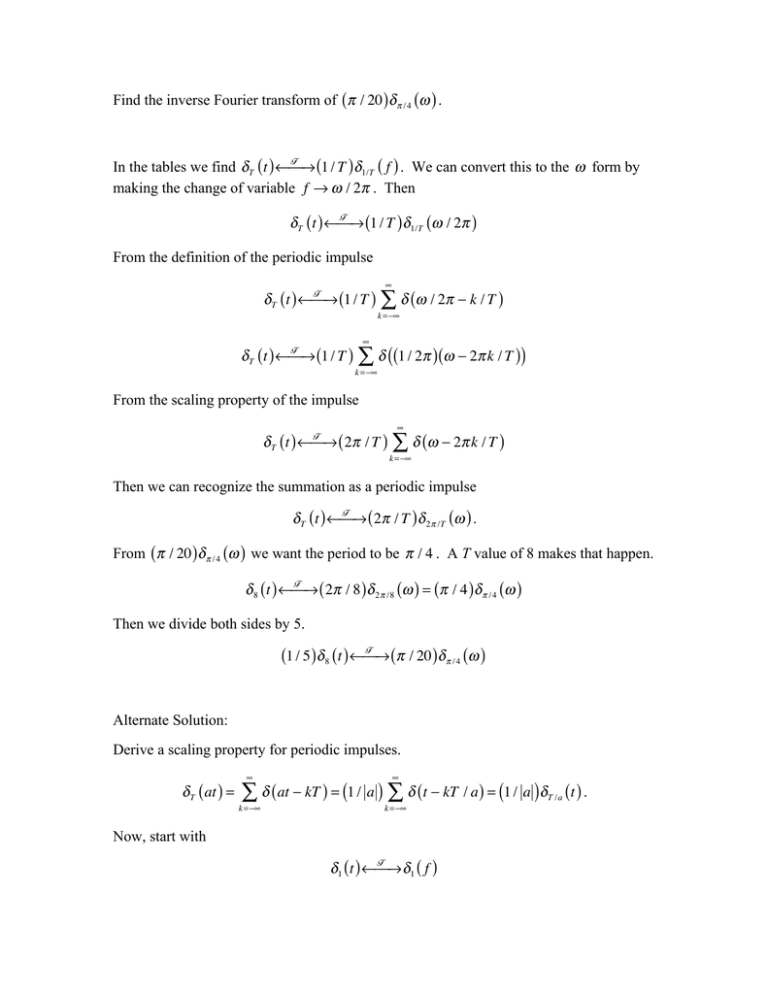( ) ( )
advertisement

Find the inverse Fourier transform of (π / 20 )δ π / 4 (ω ) . F In the tables we find δ T ( t ) ←⎯ → (1 / T )δ1/T ( f ) . We can convert this to the ω form by making the change of variable f → ω / 2π . Then F δ T ( t ) ←⎯ → (1 / T )δ1/T (ω / 2π ) From the definition of the periodic impulse ∞ F δ T ( t ) ←⎯ → (1 / T ) ∑ δ (ω / 2π − k / T ) k = −∞ ∞ F δ T ( t ) ←⎯ → (1 / T ) ∑ δ ((1 / 2π ) (ω − 2π k / T )) k = −∞ From the scaling property of the impulse ∞ δ T ( t ) ←⎯→ ( 2π / T ) ∑ δ (ω − 2π k / T ) F k = −∞ Then we can recognize the summation as a periodic impulse F δ T ( t ) ←⎯ → ( 2π / T )δ 2 π /T (ω ) . From (π / 20 )δ π / 4 (ω ) we want the period to be π / 4 . A T value of 8 makes that happen. F δ 8 ( t ) ←⎯ → ( 2π / 8 )δ 2 π /8 (ω ) = (π / 4 )δ π / 4 (ω ) Then we divide both sides by 5. F → (π / 20 )δ π / 4 (ω ) (1 / 5 )δ 8 (t ) ←⎯ Alternate Solution: Derive a scaling property for periodic impulses. δ T ( at ) = ∞ ∞ k = −∞ k = −∞ ∑ δ ( at − kT ) = (1 / a ) ∑ δ (t − kT / a ) = (1 / a )δT /a (t ) . Now, start with F δ1 ( t ) ←⎯ → δ1 ( f ) Making the change of variable f → ω / 2π and using the scaling property for the periodic impulse F δ1 ( t ) ←⎯ → δ1 (ω / 2π ) = 2πδ 2 π (ω ) Now, realizing that we want to change the period from 2π to π / 4 make the change of variable ω → 8ω to compress the ω function. The corresponding effect in the time domain is to divide by 8 and make the change of variable t → t / 8 . F → 2πδ 2 π ( 8ω ) (1 / 8 )δ1 (t / 8 ) ←⎯ Now, use the periodic impulse scaling property again on both sides. F 8 × (1 / 8 )δ 8 ( t ) ←⎯ → (1 / 8 ) × 2πδ 2 π /8 (ω ) or F δ 8 ( t ) ←⎯ → (π / 4 )δ π / 4 (ω ) . Then,dividing both sides by 5 F → (π / 20 )δ π / 4 (ω ) (1 / 5 )δ 8 (t ) ←⎯


![Solution to ECE 315 Test #4 F03 [ ] [ ]](http://s2.studylib.net/store/data/011925518_1-bdf3d19a33479d9f18f290ecbd440cbd-300x300.png)
